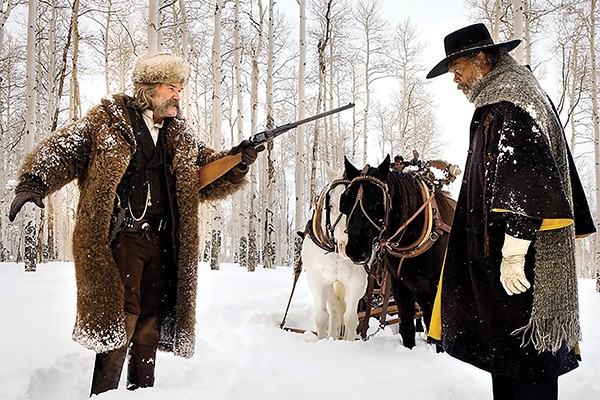In 1977, an ad touted the Heroes album with: “There’s Old Wave, there’s New Wave, and there’s David Bowie”. Like the Thin White Duke, Quentin Tarantino has become a genre unto himself. There are thrillers, there are mysteries, and there are Tarantino movies.
The buzz going into The Hateful Eight was characteristically bizarre: a Western shot on 70MM film in the age of digital. For the cinephile, anything that starts with the Cinerama logo raises expectations of wide-open vistas, such as 2001: A Space Odyssey. After the opening overture, The Hateful Eight seems like it’s going to deliver on that promise with a series of shots of a stagecoach plowing through Montana’s snowy vastness. But then the stage is stopped by a lone black figure: Marquis Warren (Samuel L. Jackson), a former Union calvary major-turned-bounty hunter, sitting atop a pile of dead bodies. The horseless man asks the coach’s charter John “The Hangman” Ruth (Kurt Russell) for a ride so he can escape the coming blizzard. Ruth is reluctant to help, because he is transporting his own bounty to Red Rocks, a woman named Daisy Domergue (Jennifer Jason Leigh), and she’s extremely valuable. But Warren is very convincing, and since they once had dinner together in Chattanooga long ago, Ruth agrees. Then, the action shifts to a long conversation inside the stagecoach, and we’ve seen the last of the beautiful western landscapes. After picking up another hitchhiker, racist sheriff Chris Mannix (Walton Goggins), the stage arrives at Minnie’s Haberdashery, a frontier tavern where the inhabitants hope to hunker down to avoid the snow. Needless to say, things go spectacularly wrong.

Kurt Russell and Samuel L. Jackson
From there, The Hateful Eight resembles Reservoir Dogs more than How the West Was Won. The motley crew trapped in the blizzard slowly circle each other spouting stupendously flowery dialogue as they look for an opening for murder. If there’s one thing QT is good at, it’s writing a menacing speech leading up to mayhem, and his language machine is cranking double time. Jackson and Russell provide ideal vessels for the profane wordsmith, but from Tim Roth to Bruce Dern to Michael Madsen, there really are no weak links here. Lies are told, identities shift, Pynchonesque names are checked, and poison surreptitiously administered. Tarantino uses the fantastically expensive and obsolete camera technology not to open up spaces, but to present the whole of the interior of Minnie’s as a single stage set where he can move his crack actors around like a theater director.

SLJ. ’Nuff said.
There are a hundred reasons why a three-hour widescreen epic that devolves into an Agatha Christie play shouldn’t work, and yet, at least after the first viewing, The Hateful Eight comes off as more satisfying than Inglourious Basterds or Django Unchained. It’s the critic’s job to explain this stuff, but Tarantino creates alchemy that defies easy description. Sometimes things just work.